
by Eddie Powell | Nov 11, 2014
Compost is partially decomposed organic matter or anything that was once a living plant. It is the product of controlled decomposition of organic materials by microorganisms. Humus is completely decomposed organic matter.
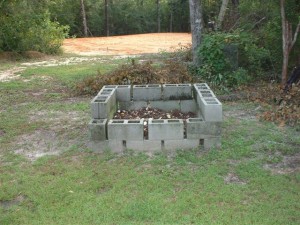
Concrete Block Compost Bin
Photo Credit : Eddie Powell
Green and brown materials with favorable proportions of carbon and nitrogen (C:N) (25:1) offer the microorganisms a “complete meal“. This helps the breakdown of the compost. Greens having high nitrogen and browns having high carbon.
“Green”
- High Nitrogen
- Fast to decompose
- Nitrogen provides the microbes with the raw element of proteins to build their bodies and reproduce.
Examples: manure, kitchen waste, grass clippings, inorganic nitrogen rich fertilizers.
“Brown”
- High Carbon
- Slow to decompose
- Carbon is the energy source for the microbes that help break down the materials.
Examples: leaves, wood chips, straw, sawdust.
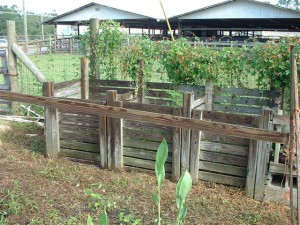
Wooden Compost Bin
Picture Credits : Eddie Powell
Layering in Compost Bin
The general rules for composting: 3 – 4″ layers alternating Green (high nitrogen) and Brown (high carbon) materials. Water each layer as you build it so material is moist not wet, like a wrung sponge. End with a Brown layer on top. Thin layers help prevent anaerobic (smelly) pockets from developing and allows microbes access to both Green and Brown food sources. Do not use meat (eggshells are OK) or dog / cat manure in your compost.
Make sure to filter your composting system because it may not break down all the larger materials, such as corncobs or wood chips.
When you screen your compost, any material larger than your screen size will be removed. The screened particles can be placed back in the compost bin to provide aeration. Additionally, the microbes attached to these pieces will help jump-start the new composting process.
For more information check out this site: Compost Tips for the Home Gardener.
by Taylor Vandiver | Oct 25, 2013
Caution…Worms at Work!
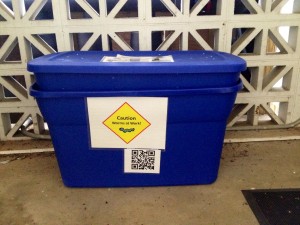
Vermicomposting bin at the Leon County Extension Office.
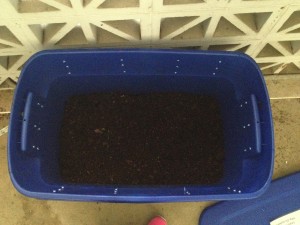
It’s difficult to see, but our worms are hard at work composting leftovers!
Many home gardeners may have thought about composting, but may not have the time, the space or, let’s face it, the patience. Well then vermicomposting is ideal to satisfy those conditions! Vermicomposting is the process of using worms and micro-organisms to turn food waste into a nutrient-rich compost called worm castings. Worm composting bins can take up less space than traditional composting bins and can even be kept inside.
Bins can be purchased or made at home, for those who want to compost on a budget. If the home gardener is planning on making their own there are a few things that should be considered. Make sure that the container won’t absorb too much water (such as cardboard), because worms need to stay moist. The container should also be made of a non-clear material. A good example would be 1-18 gallon plastic (not clear) container or a Styrofoam container with a lid. Holes need to be drilled about 4 inches from the top of the bin. Covering the air holes with a type of screen is a good idea to prevent the escape of the composters.
After the bin has been constructed bedding (shredded newspaper, etc.) will need to be placed at the bottom. The bedding should be moistened and then potting soil added on top of that. This will provide a good living habitat for your worms. The Number of worms that need to be added will depend on the container size. When getting worms, make sure to use red wigglers (Eisenia fetida) or African Nightcrawlers (Eudrilus eugeniae). Unlike earthworms found in the garden, these worms thrive in composting bin conditions. They can usually be found at bait stores or local worm farms.
Now its time to put them to work! Worms can be fed daily or weekly. One pound of worms can be fed about half a pound of kitchen scraps per day. When adding scraps avoid using animals products like eggs, cheese or meat. The ideal meal should include small scraps of vegetables, fruits, coffee grounds, bread and paper. When adding the scraps be sure to bury them under the soil. Store the worm bin in an area that does not receive direct sunlight and stays at a constant temperature of about 60 to 80 degrees. Be sure to have a lid for your container, this will keep light out and will also help prevent the appearance of flies. One pound of worms can turn 65 pounds of garbage into garden compost in about 110 days. Compost should be harvestable in a matter of months!
Vermicomposting is a great way to compost for those living in an apartment or those that have kitchen scraps as a main source of compost materials. Worm castings are used just like normal compost. Add them to plants and gardens as a soil amendment, use them in potting soil, or make a compost tea.
For more information contact your local UF/IFAS Extension Office.
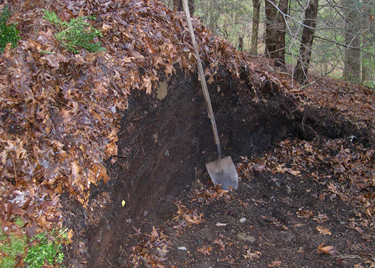
by | Aug 5, 2013
With all of the rainy weather Northwest Florida has been having this summer, plenty of excess yard debris is littering our yards. Don’t put it in the landfill, Compost It !
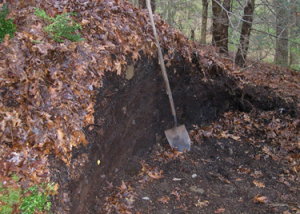
Compost Pile
Compost is used primarily in bed preparation to improve the soil and can even be used in preparing potting mixes. Partially composted material also can be used as mulch. And since homemade compost is free, it helps reduce the cost of gardening – which means more money left over to buy plants.
Returning these organic materials to the garden maintains natural biological cycles and is an ecologically sensible means of recycling organic waste. It is never very efficient nor environmentally friendly to pile up leaves and grass clippings in bags on the curb to be hauled away to rapidly filling landfills and then go out and buy peat moss that has been dug up and shipped in from Canada.
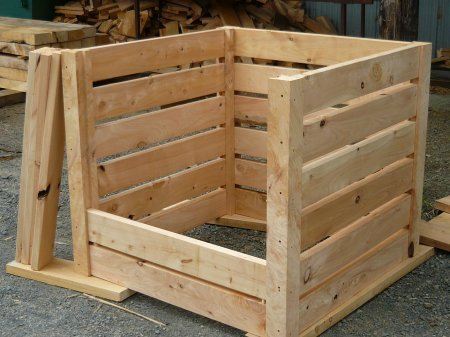
Build Your Own!
Compost piles should be located in a convenient, but out-of-the-way, location. A source of water nearby is helpful. Avoid locating the pile against fences or other structures made out of wood, because the constant moisture can cause decay. Make the pile about 3 feet wide by 3 feet deep by 3 feet wide to 5 by 5 by 5 in size. Anything smaller will not decompose as well, and larger piles are more difficult to work.
Although compost can be made just by stacking organic matter in a pile, most gardeners prefer to enclose the pile in a bin. There are a number of commercial bins on the market, or you can make your own very easily. A 15-foot-long piece of wire fencing material bent into a circle and fastened with a few pieces of wire is inexpensive, easy to build and works well. Avoid using untreated wood to build the bin, because that could lead to termite problems.
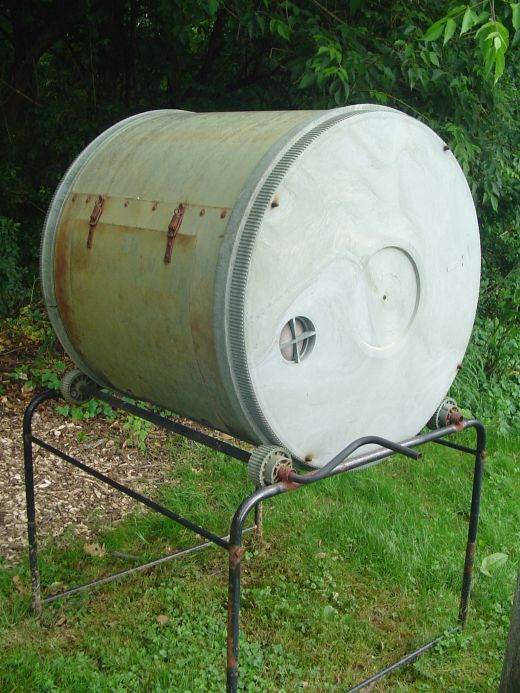
Commercial Bins Are Available
Compost can be created simply by piling up organic matter and allowing natural decomposition to take place (this is sometimes called passive composting). There is nothing really complicated about it, although using this method requires patience. Depending on circumstances, it may take six to 12 months for the organic matter to fully compost.
Typically, composting uses various techniques to speed up the natural breakdown of yard waste. It’s important to remember that raw organic material is converted into compost by the action of fungi and bacteria. In active composting, processes are set in place to make these organisms work faster and more efficiently.
These fungi and bacteria require adequate nitrogen, oxygen and moisture to decompose organic matter rapidly. The composting process attempts to provide these requirements, and the better those essentials are supplied, the faster the process will occur. Shredding or finely chopping materials also greatly speeds up the process.
As the microbes decompose the organic materials, temperatures within the pile may approach 160 degrees at the center. When properly done, this process produces a rich, earthy smell, not the bad odors many gardeners fear will occur. In addition, properly maintained compost piles will not attract and harbor vermin such as rats.
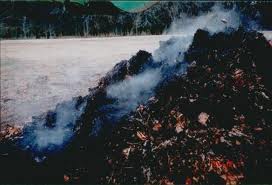
During Decomposition Compost Piles Get Very Warm
Try to include a variety of materials to encourage rapid decomposition. The more types of acceptable materials that are added the better the composting process.
Brown materials, such as brown leaves or chipped branches and stumps, are relatively low in nitrogen. Adding a commercial fertilizer or an organic fertilizer (such as blood meal) that contains nitrogen encourages rapid, thorough decomposition when these types of materials provide the bulk of what is being composted. A light sprinkling is applied over each 8- to 12-inch layer of organic matter as the pile is built.
If the pile is mostly green matter, turn it weekly to keep it loose and oxygenated.
Organic materials that can be used for composting include fallen leaves, grass clippings, shredded hedge clippings, raw vegetable and fruit trimmings, coffee grounds, dead houseplants and old flower arrangements. Manures, such as cow, horse, rabbit or poultry manures, make excellent additions to the compost and are relatively rich in nitrogen.
On the other hand, never put cooked foods, grease, meat, seafood scraps, fat or dog or cat droppings in the pile.
Oxygen is provided by enclosing the pile in a bin that has sides with a lot of ventilation openings, which allow air to move in and out. Turning the pile occasionally is labor intensive, but it ensures the pile is well aerated.
During dry weather it may be necessary to water the pile to maintain adequate moisture levels. Dry organic matter will not decompose. The pile should stay moist, but not constantly soggy. A pile that stays too wet does not contain enough oxygen and may produce sour odors. If this happens, turning the pile will correct the problem.
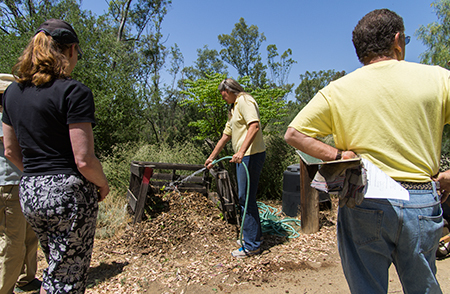
Water May Need to be Added During Dry Periods
As materials compost they lose more than half of their volume. When compost is ready for use, it should be dark brown and crumbly with much, or all, of the identity of the original material lost.
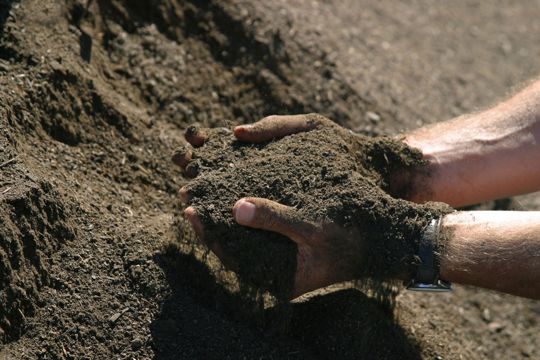
The Finished Product
The time it takes to finish varies depending on the materials used, how finely they were chopped and how well the appropriate moisture and oxygen levels were maintained. Two to six months is typical, but it can occur much faster. For more information, check out this great UF / IFAS publication on composting.












